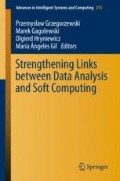Abstract
As there are many various methods for time series prediction developed but none of them generally outperforms all the others, there always exists a danger of choosing a method that is inappropriate for a given time series. To overcome such a problem, distinct ensemble techniques, that combine more individual forecasts, are being proposed. In this contribution, we employ the so called fuzzy rule-based ensemble. This method is constructed as a linear combination of a small number of forecasting methods where the weights of the combination are determined by fuzzy rule bases based on time series features such as trend, seasonality, or stationarity. For identification of fuzzy rule base, we use linguistic association mining. An exhaustive experimental justification is provided.
Access this chapter
Tax calculation will be finalised at checkout
Purchases are for personal use only
Preview
Unable to display preview. Download preview PDF.
References
Agrawal, R., Srikant, R.: Fast algorithms for mining association rules. In: Proc. 20th Int. Conf. on Very Large Databases, pp. 487–499. AAAI Press, Chile (1994)
Armstrong, J.S., Adya, M., Collopy, F.: Rule-based forecasting using judgment in time series extrapolation. In: Armstrong, J.S. (ed.) Principles of Forecasting: A Handbook for Reasearchers and Practitioners. Kluwer Academic Publishers, Boston (2001)
Assimakopoulos, V., Nikolopoulos, K.: The theta model: a decomposition approach to forecasting. International Journal of Forecasting 16(4), 521–530 (2000)
Bates, J.M., Granger, C.W.J.: Combination of forecasts. Operational Research Quarterly 20, 451–468 (1969)
Box, G., Jenkins, G.: Time Series Analysis: Forecasting and Control. Holden-Day, San Francisco (1976)
Collopy, F., Armstrong, J.S.: Rule-based forecasting: Development and validation of an expert systems approach to combining time series extrapolations. Management Science 38, 1394–1414 (1992)
Dvořák, A., Štěpnička, M., Vavříčková, L.: Redundancies in systems of fuzzy/linguistic if-then rules. In: Proc. 7th Conference of the European Society for Fuzzy Logic and Technology (EUSFLAT-2011) and LFA-2011. Advances in Intelligent Systems Research, pp. 1022–1029. Atlantic Press, Paris (2011)
Hájek, P.: The question of a general concept of the GUHA method. Kybernetika 4, 505–515 (1968)
Hájek, P., Havránek, T.: Mechanizing hypothesis formation: Mathematical foundations for a general theory. Springer, Heidelberg (1978)
Hájek, P., Holeňa, M., Rauch, J.: The GUHA method and its meaning for data mining. Journal of Computer and Systems Sciences 76, 34–48 (2010)
Hamilton, J.D.: Time Series Analysis. Princeton University Press, New Jersey (1994)
Hyndman, R., Koehler, A.: Another look at measures of forecast accuracy. International Journal of Forecasting 22, 679–688 (2006)
Hyndman, R.J., Athanasopoulos, G., Razbash, S., Schmidt, D., Zhou, Z., Khan, Y., Bergmeir, C.: forecast: Forecasting functions for time series and linear models (2014), http://CRAN.R-project.org/package=forecast (r package version 5.3)
Kupka, J., Tomanová, I.: Some extensions of mining of linguistic associations. Neural Network World 20, 27–44 (2010)
Lemke, C., Gabrys, B.: Meta-learning for time series forecasting in the nn gc1 competition. In: Proc. 16th IEEE Int. Conf. on Fuzzy Systems, Barcelona, pp. 2258–2262 (2010)
Makridakis, S., Fildes, R., Hibon, M., Lewandowski, R., Newton, J., Parzen, E., Winkler, R.: The accuracy of extrapolation (time-series) methods - results of a forecasting competition. Journal of Forecasting 1, 111–153 (1982)
Makridakis, S., Hibon, M.: The m3–competition: results, conclusions and implications. International Journal of Forecasting 16, 451–476 (2000)
Makridakis, S., Wheelwright, S., Hyndman, R.: Forecasting: methods and applications. John Wiley & Sons, USA (2008)
Newbold, P., Granger, C.W.J.: Experience with forecasting univariate time series and combination of forecasts. Journal of the Royal Statistical Society Series a-Statistics in Society 137, 131–165 (1974)
Novák, V.: Perception-based logical deduction. In: Reusch, B. (ed.) Computational Intelligence, Theory and Applications. ASC, pp. 237–250. Springer, Heidelberg (2005)
Novák, V.: A comprehensive theory of trichotomous evaluative linguistic expressions. Fuzzy Sets and Systems 159(22), 2939–2969 (2008)
Novák, V., Perfilieva, I., Dvořák, A., Chen, Q., Wei, Q., Yan, P.: Mining pure linguistic associations from numerical data. International Journal of Approximate Reasoning 48, 4–22 (2008)
Sikora, D., Štěpnička, M., Vavříčková, L.: Fuzzy rule-based ensemble forecasting: Introductory study. In: Kruse, R., Berthold, M., Moewes, C., Gil, M.A., Grzegorzewski, P., Hryniewicz, O. (eds.) Synergies of Soft Computing and Statistics. AISC, vol. 190, pp. 379–387. Springer, Heidelberg (2013)
Sudkamp, T.: Examples, counterexamples, and measuring fuzzy associations. Fuzzy Sets Systems 149(1), 57–71 (2005)
Štěpničková, L., Štěpnička, M., Dvořák, A.: New results on redundancies of fuzzy/linguistic if-then rules. In: Proc. 8th Conference of the European Society for Fuzzy Logic and Technology (EUSFLAT-2013), pp. 400–407. Atlantic Press, Milano (2013)
Štěpničková, L., Štěpnička, M., Sikora, D.: Fuzzy rule-based ensemble with use linguistic associations mining for time series prediction. In: Proc. 8th Conference of the European Society for Fuzzy Logic and Technology (EUSFLAT-2013), pp. 408–415. Atlantic Press, Milano (2013)
Author information
Authors and Affiliations
Corresponding author
Editor information
Editors and Affiliations
Rights and permissions
Copyright information
© 2015 Springer International Publishing Switzerland
About this chapter
Cite this chapter
Burda, M., Štěpnička, M., Štěpničková, L. (2015). Fuzzy Rule-Based Ensemble for Time Series Prediction: Progresses with Associations Mining. In: Grzegorzewski, P., Gagolewski, M., Hryniewicz, O., Gil, M. (eds) Strengthening Links Between Data Analysis and Soft Computing. Advances in Intelligent Systems and Computing, vol 315. Springer, Cham. https://doi.org/10.1007/978-3-319-10765-3_31
Download citation
DOI: https://doi.org/10.1007/978-3-319-10765-3_31
Publisher Name: Springer, Cham
Print ISBN: 978-3-319-10764-6
Online ISBN: 978-3-319-10765-3
eBook Packages: EngineeringEngineering (R0)

